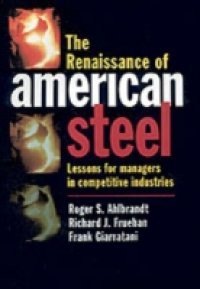By the end of the 1980s, the once mighty U.S. steel industry seemed on its last legs. More than a quarter of a million jobs had been lost, and communities like Pittsburgh and Bethlehem were devastated. Yet today, the industry again stands as a world-class competitor. In The Renaissance of American Steel, Roger Ahlbrandt, Richard Fruehan, and Frank Giarratani illuminate the forces behind this remarkable comeback, drawing valuable lessons for managers not only in the steel business but in any business now battling the global marketplace. Citing evidence from a wide range of companies in the U.S., the U.K., and Japan, and clearly explaining the basics of steel production, the authors show how the industry's rebirth resulted both from the downsizing of big companies and the rise of minimills capturing markets from the larger companies. They describe how large, traditional firms--including U.S. Steel, British Steel, and Nippon Steel--recognized that they had to reduce the scope of their operations and reorganize to become more competitive. U.S. Steel CEO Tom Graham, for instance, closed plants and refocused the firm's resources on the market for flat-rolled products. The book also examines how minimills--such as Nucor, Birmingham Steel, Oregon Steel, Tokyo Steel, and Co-Steel Sheerness--have redefined the industry's structure and competitive dynamics. Nucor, in particular, has emerged as the leader among the minimills--the largest electric furnace-based steel company in the U.S., with annual sales exceeding $3 billion. The reader learns how CEO Ken Iverson, recognizing the opportunities to be seized if Nucor moved beyond traditional products (such as steel joists and rebar), created the most innovative steel mill in the world, with a consistent record of investing in new technologies to lower operating costs and to move into sophisticated, value-added products. Throughout the book, the authors offer sharp insights into the steel industry in the U.S. and abroad--but more important, they highlight the lessons to be learned for managers in all industries. The authors conclude, for instance, that success for both large and small steel producers depends on a critical interplay of factors that touch on leadership, new technologies, and decentralized management. Effective leaders, the authors find, don't micromanage; they set a goal for the company and communicate it broadly to gain employees' commitment. High-performing companies aggressively seek technical know-how, even if it means purchasing it from foreign competitors or securing joint agreements. And finally, successful companies decentralize, empowering employees far down in the organization to handle daily decisionmaking. This in-depth analysis of a radically changed industry speaks volumes about the value of flexibility in business. It is an essential resource for any manager working in today's global economy.



















